#fictional biology
Text
BENREY BIOLOGY: Sweet Voice



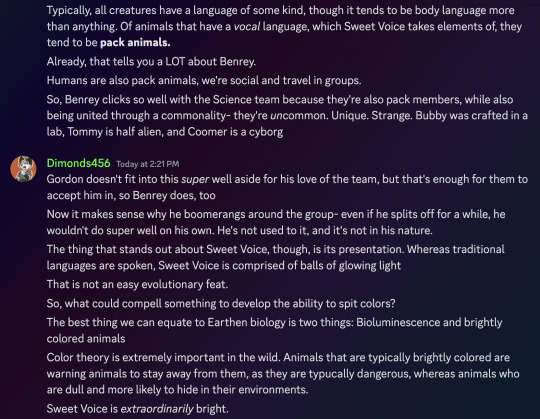


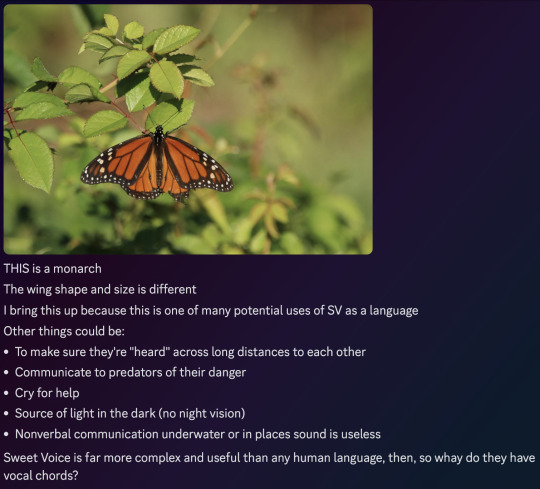

I HAVE MORE BUT THIS IS MY STOPPING POINT FOR NOW
Benrey Biology Booklet
Sweet Voice | Shapeshifting/Size Altering | Internal Structure | Behavioral Patterns
Will add the links as I post 'em!
163 notes
·
View notes
Text
The Gargantuan Fossil
This post was from the beginning of my project, thus some information I’ve written here is outdated. Please read my recent posts to see up to date information.
The Gargantuan Fossil is one of the most recognizable parts of the mid-portion of Subnautica’s gameplay. Its sheer size strikes both terror and awe into the hearts of players who stumble upon it. It’s unfortunate that only a third of the creature’s fossilized remains can be seen. Even using the Freecam command to check under the map reveals that the rest of the skeleton remains unmodeled. This is all we have of the Leviathan.

“Gargantuan Fossil” is quite the accurate name, considering just a third of this creature’s skeleton measures 402 meters in length, with the creature’s total size being an estimated 1,100-1,500 meters. Just the skull itself is under 100 meters, and our human player character can nestle comfortably in even its smallest eye socket. I would’ve tried to show our human character’s model for a size comparison, but this thing is so large you wouldn’t even be able to see him.
There have been many different reconstructions of this behemoth of a fossil, the most popular being this commission piece made by Tapwing, for the YouTuber Anthomnia, shown below. And while it’s cool, it’s... not all that accurate.

In the past, I actually helped create a Gargantuan Leviathan mod based off Tapwing’s concept, working alongside other incredibly talented artists (who will remain anonymous, they can talk about their experiences as they please) and some... not so savory individuals. I don’t want to be associated with that old Garg. This reconstruction project is both a way for me to move on and make something better than what I had in the past, and to test my skills and knowledge in the various natural sciences.
Although there is a second specimen, the skull of a younger instance, this fossil holds no significant data outside of showing just how small these creatures start out as. As shown in the image below, despite being a much younger instance, our player character could still fit inside the Leviathan’s smallest eye socket, although it wouldn’t be as spacious as its adult counterpart.

The game’s PDA (Personal Data Assistant) states that the Gargantuan Fossil is approximately 3 million years old, which is INCREDIBLY RECENT. For reference, 3 million years ago we still shared the planet with multiple other hominid species like Australopithecus afarensis back in the mid Pliocene. The Subnautica we know today is a byproduct of a mass-extinction of megafauna, such as Leviathans. My guess as to how the Gargantuan got this big is a combination of deep-sea gigantism and an evolutionary arms race against the other megafauna alive during its time, with prey attempting to become larger than its predator to avoid predation, and the predator growing to continue this cycle. When this ancient ecosystem of leviathan-class super predators collapsed, likely because of the meteor that struck Planet 4546B, the Gargantuan Leviathan was out of a substantial food source and went extinct.
It could be possible that these creatures even gave live birth due to their serpentine body and massive size, making them too large for life in the shallows, where laying eggs is easiest.
NOW. LET’S TALK ABOUT THE BONES!! It’s important to figure out if the Gargantuan Leviathan had a cartilaginous skeleton or a bony one, so let’s count the bones!!
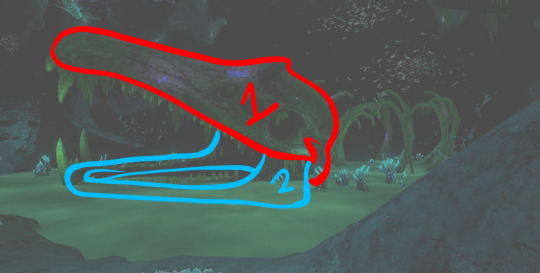
There’s TWO WHOLE BONES!!! AND IF YOU LOOK NEXT TO IT!! THOSE RIBS ARE BONES TOO!!!! UWAA!!! SO MANY BONES!!!! How can we tell this is bones? It’s simple!
Cartilage is rubbery and flexible, so it doesn't fossilize well, while bone is hard and rigid, perfect fossil material!! Cartilaginous skulls also tend to be made up of many little interlocking bones, with bony skulls being made up of only a small handful!

Another thing I found interesting about the Gargantuan Skull is that it seems to have a ball and socket joint? This could have just been a similar mishap to the top and bottom jaws being fused in the skull’s model, but I’m trying to keep things as close to the original anatomy as possible. The ball and socket joint probably evolved to help with the burden of such a massive and heavy skull and allowing for greater speed and range of motion. In a world full of Leviathan-class predators, being able to have a wide range of motion would be extremely beneficial in locating both potential predators and prey.
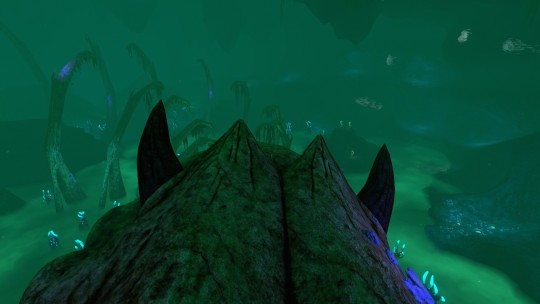
Despite its immense size pushing the claim this Leviathan was an apex predator, it sports a small pair of horns, which is unheard of in large apex predators here on Earth. The darker coloration leads me to believe that these aren’t just horn cores, but the entire horn. These horns were most likely used to assist in defending itself against predators while it’s still small and vulnerable. It could also be a possibility they were used for threat displays and territory fights though it seems unlikely due to their small size. Sexual displays are also unlikely since just about every creature in Subnautica seems capable of asexual reproduction, as noted in the PDA entry for eggs. Asexual reproduction seems to be a very ancient basal trait in Planet 4546B’s evolutionary lineage and was most likely evolved to help species persevere even with low numbers and harsh conditions, preventing the dangers of inbreeding.
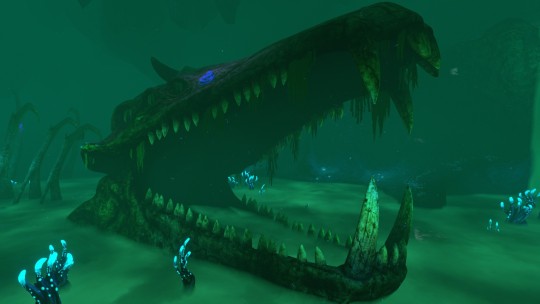
Overall, the skull’s shape and tooth structure suggest a piscivorous diet (of course it eats fish, the planet’s 99% water), and its shape specifically is reminiscent of an Orca and Redondasaurus.
The lack of nostrils stumps me, there’s no openings in the skull aside from its eye sockets, however there’s also no evidence for a gill apparatus. I’m... going to have to come back to that at a later date. Though I personally believe the Gargantuan Leviathan was an air breather due to the lack of evidence for gills.
OKOK, ENOUGH ABOUT THE SKULL ASRIEL, WHAT ABOUT THE RIBS?

WELL... THE RIBS ARE... SOMETHING.

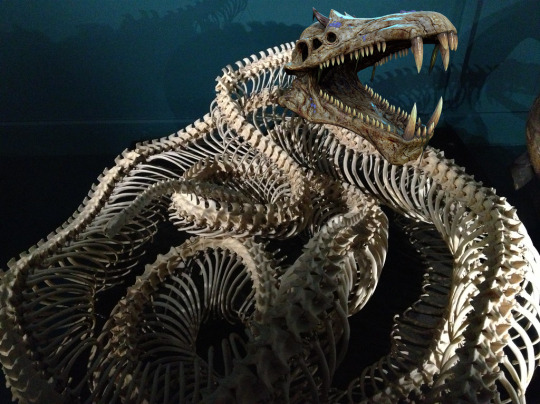
Behold! My very poor photomash of the same two images to show the total approximate length of the Gargantuan Leviathan, and a bad edit to show off what I believe the whole skeletal system would look like! (skeleton image credit)
Despite the game’s PDA describing the Gargantuan Leviathan’s body as “eel-like,” its skeletal structure is more reminiscent of a snake. The ribs show no indication of limbs, so it probably had a dorsal fin similar to eels or sea kraits.
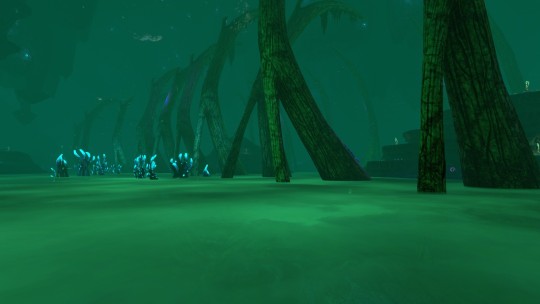
One thing I’ve noticed about the Gargantuan’s ribcage is the existence of what appear to be bony, avian-like uncinate processes, which help the trunk’s muscles pump in and air out of the body, adding onto the idea that this leviathan breathed air. These uncinate processes in diving birds are especially long, which help reinforce the body and musculature, allowing the animal to stay underwater for longer periods of time.
My hypothesis for the role the Gargantuan Leviathan played in its ecosystem is similar to the Sperm Whales of our world, taking in large amounts of air before diving into the depths to fetch their food.
Next week, I’ll be doing more research into the skeleton and possibly beginning work on fleshing the Garg out! If there are any sciencey folks out on Tumblr who want to add their own input, feel free!! I want information!! Correct me if I got anything wrong!!
#long post#VERY long post#speculative biology#speculative paleobiology#paleontology#marine biology#fictional biology#subnautica#character analysis#monster biology#leviathan#gargantuan leviathan#essay
405 notes
·
View notes
Text
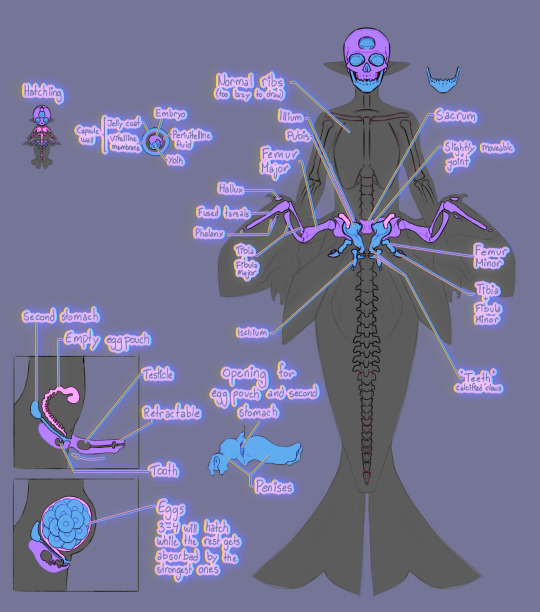
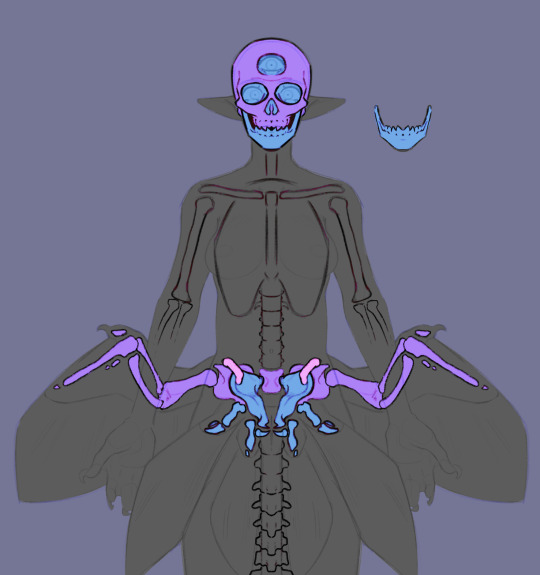
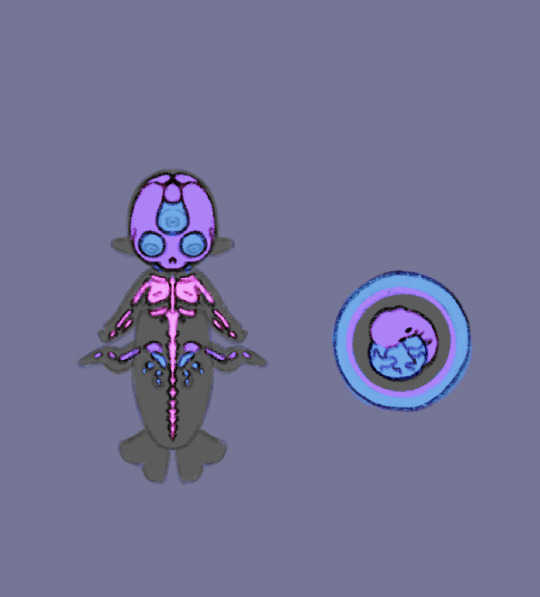

The biology of my three eyes male siren
57 notes
·
View notes
Text
Happy Halloween!!
To celebrate, here's a biology sheet regarding Etherian sorcery magic and how it works. I also digressed a little bit into the effects the Spell of Obtainment had on Shadow Weaver’s appearance!



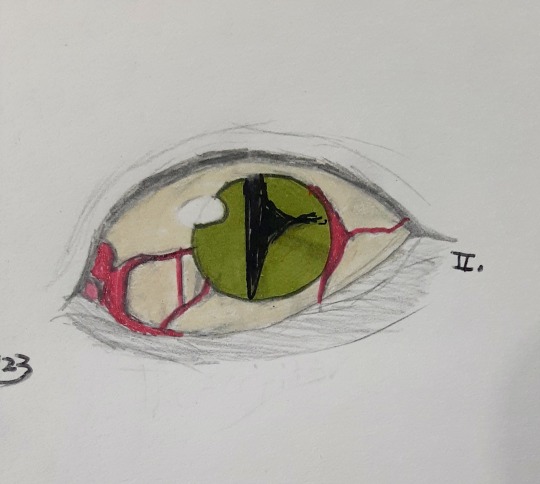
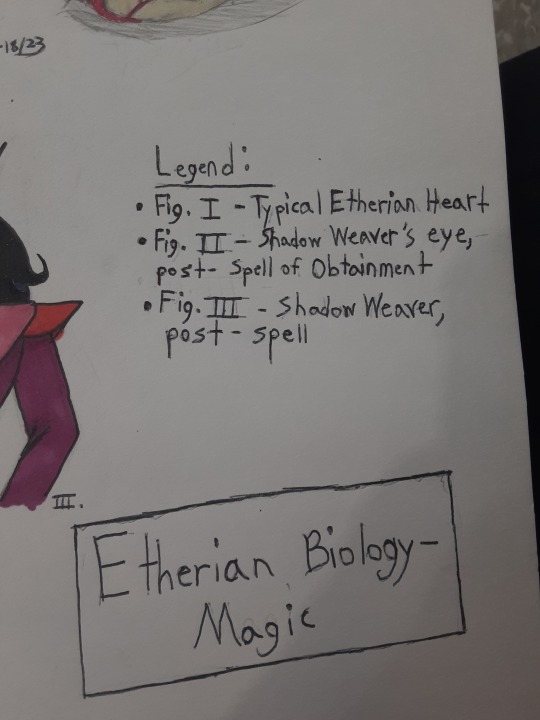

#my art#traditional art#she ra#she ra and the princesses of power#spop#spop fanart#shadow weaver#light spinner#Fake biology#fictional biology#spop shadow weaver#she ra spop#Magic#fantasy#fantasy art#she ra season 5#she ra spoilers#she ra season five
28 notes
·
View notes
Text
Aweseome "documentary" about the animal species in Subnautica.
Includes spoilers, obviously.
youtube
17 notes
·
View notes
Text
Going to the doctor is a lot more fun when you get treats!
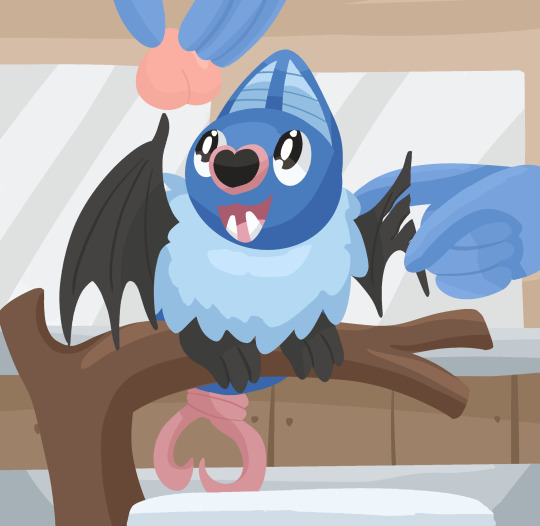
A visit to the vet is stressful for any Pokémon, so we train them with positive reinforcement to make it much easier for the keepers, veterinary staff, and of course the Pokémon. First, we get them comfortable with the keepers inspecting sensitive areas like their teeth, belly, paws for any visible issues like sores and scrapes. Then, once they’re comfortable with being transported to the on-site veterinary office, they’re able to have normal check-ups!
Lovebird is a bit of a regular at the vets’, so she’s a pro at check-ups! She came to us with a severely injured wing, meaning that she couldn’t be returned to the wild. Due to her inability to fly, she would be incredibly vulnerable to predators and unable to find her own food. However, here at the Wyndon Zoo, she gets regular check-ups from our world class veterinary staff as well as lots of yummy mealworms and berries for being such a brave little Swoobat!
109 notes
·
View notes
Text

more sketchy notes, this time on 4 winged Avii (or Tetra)
compared to regular Avii they are a rare mutation that can happen randomly(at birth, Uri'el is a special case as the sword was supposed to act as emergency measure and iwas able turn any Avii or human with enough magic power to survive into one) every 200/300 years, Tetras have such long lifespans that are believed to be immortal.
While all Avii are proficient in magic Tetras arethe ones who are most conected and attuned with the flux and that's why they end up getting important roles in the Avii society as leaders and high priests, since they are so powerful and their lifespan is so long, everytime a new tetra is born and has reached adulthood the previous ruling one will "hybernate" in a crystal coffin (in ancient times they were sacrificed but it's deemed unethical now), random fact all Tetras have naturally golden colored talons and their blood turns gold when interacting with magic.
All Avii have an enhanced color vision and are able to see more colors than humans, but less than an actual bird, they also can clearly see spells emitting a faint glow even when they are not visible to the naked eye, ability that helped building their skills as intricate spell crafters
While it's hard to distinguish a female Avii from a male Avii aside some specific subspecies cases who display sexual dismorphism, for Tetras the line is even blurrier as they phisically have characteristics of both, some may display more masculine or more feminine features(down there) but they are both always present, despite presenting both elements they are always infertile as many cases of mutations in nature, their female organs tho will produce an egg every 50 years of so after reaching maturity, since keeping track of time is trivial for them some Tetras use that as a way to calculate time.."oh! won't you look at that! another 50 years have passed"
WARNING non canonical cross species breeding content following
In the siren AU a dew colonies of Avii and theirs leaders escaped from the war to some remote islands in the kingdom of sea together with humans, living together for centuries they found out that while Tetras couldn't have fertile eggs with Avii they could with humans and viceversa giving birth to Sirens , humans were able to as the most adabtable species (it would not have been possible with a padoor and an avii but it could with an human and a padoor as well),the women bearing siren children tho would often sustain injuries or even lose their lives cause of the partially developped talons of the children as they are unable to create eggs making the male partner x tetra the most successful in the increase of the siren population, avii are technically able to generate sirens too but the chances are lower than with a tetra
10 notes
·
View notes
Text
The Taur Virus
This strange infection afflicts all variety of species. The disease transfers through the bite of an infected individual. Once in an animal's system it will begin to modify the victim's upper spinal region, lengthening it considerably. Over the next few months the victim's flesh will change, showing stubby arm-growths after only a few days and a full rib cage and functional shoulders after around three weeks. Eventually infection leads to the neck and head mutating into a full humanoid torso, often retaining some aspects of the original biology (such as horns or fur). There is no known cure for the condition, and most livestock are killed soon after symptoms emerge. There are however many wild examples of "taurs", the most commonly known being the wild horse-taurs (or centaurs) of the lower steppe. The condition has been found in a variety of mammals, from big cats and deer to elephants and dolphins, as well as in large reptiles and even fish (though these should not be confused with merfolk).
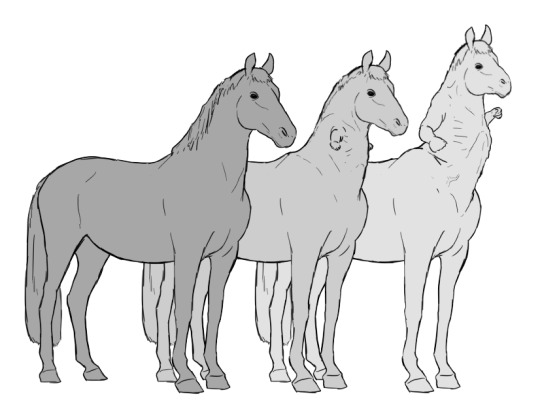
There are rumours that the infected gather in groups and on occasion display human-like behaviour. Though evidence for this is minimal, and it is commonly agreed that the victims of this disease retain their animal instincts and faculties, having only very limited use of their new appendages.
The origin of the virus is unknown, and the name is a misnomer, "taur" being the word for "bull" despite the infection's humanoid symptoms. The name possibly came from the legendary half-man half-bull, however they were human from the shoulders down, not the other way around.
So far there have been no known cases of Taur infection in humans. Thank the Gods for their mercy.
#centaur#mythology#fictional biology#fantasy#world building#horror#horse#taur#illustration#lore#fiction#artists on tumblr
14 notes
·
View notes
Photo


(The first and second pages of my alien biology research journal series. Written in-universe by novice exozoologist Dr. Beck Koslovsky in 2504 on a research expedition for Tarkovicke Inc .)
(Note - On the first page I use the creatures called trimmings from Darian Quilloy’s Vita Carnis series. This series is inspired by Vita Carnis. Go check it out on Youtube, it’s very good.)
28 notes
·
View notes
Text
If I had to create a gem species like in Steven Universe and Houseki No Kuni (I know, I know. But as a MADD, a mineralogy nerd and a huge fan of both series, I want for once to pacify this little whimp of mine), I'd probably make them live in a cave/underground enviroment.
Their cities would be build underground an their houses/room, inside cave corners.
A town of Minerals (the species' actual name) is called a Colony and it's not lead by the ones whos "gem-core" (the irl gem who matches their biology/appearences) has the strongest hardness on Moth's scale. They are chosen on reliability and empathy/simpathy and other factors.
A baby mineral is called a geode and a group of minerals is called a cluster
While I still like this species to look a bit more humanoid, they wouldn't look just like colorful people! I want to give them some features that distances them a bit from our fav gems: what about something like horns (perhaps made out of crystals??) And crystal grows over their bodies? Maybe a tail??
These mineral-people aren't actually made out of pure gemstone. They are called "rock elementals" for their biological structure: their blood, flesh and other bodly parts share the same chemical composition of IRL gems (a citrine quartz have both silicius and steel in their body).
This determines a few factors: the blood/flesh/skin/irises and other features' colors who are very close to match the irl gem, and also some health-related things (Mineral whose "gem-core" is colorless such as phantom quartz or goshenite would be very sensitive to the sun-light, like albino creatures, because there are not impurities that colors their skin. For example, a "Sapphire-person" would get bluer if they get a sunburn).
Also, there can be metal-cores too but they are rare. Metals can be born from two minerals who have a gem-core (and this usually happens because the metallic impurities in their body are commoner than the other rock impurities), or can be born from a metal and gem couple
Also Minerals are not immortals!!
Their life lenght depends on many factors, but they get old and die like any other living being (I'd like to think that the type of gem-core is a factor on the duration of the mineral)
Speaking about gem-core, Minerals are not named after that ofc (it can works as a nickname such as Dora for a Labradorite, but most of the time the name is not linked to the irl gem)
And that's it prettu much...
What do you think about it? Feel free to let your questions in the ask box
And any suggestion is more than welcome!
#one last thing:#in both SU and HNK gems are also asexuated and genderless#which is something very valid and I do respect a lot#but to not make my species too close from those series I decided the minerals here are not asexuated and can have any gender#the biological sex part isn't relevant actually#There are also two words to describe the different sexes: gems are for females and crystals are for males#I just wanted to specify#I hope this isn't an issue#it's just that I have this stupid obsession to make everything as furthest as possible#also they do eat and sleep like any other living being#Tama's thought#original species#original character#oc#minerals#mineralogy#fictional biology#steven universe#houseki no kuni#also this should be obvious but I'm not gonna publicise any of this outside the internet#unlike my other projects this is very clearly inspired by those two medias and I don't want to get any money#this is just for purely fun!#maladaptive daydreaming#paracosm#fan paracosm#madd#actually madd
15 notes
·
View notes
Text

We've discovered some new specimens! First up is the Deep Sea Vasefish, unfortunately our internal cameras had some issues but! This species burrows into the sea bed, enticing small creatures into its mouth with its pseudo foliage
76 notes
·
View notes
Text
Faerie Biology, Section 2; Nature
Faeries are magical beings, but the only source of magic is life. This magic is created as a byproduct of the development of Faerie young and eggs. Once laid, this magical byproduct is no longer accessible to the Fae.

Due to this, Faeries constantly make eggs to allow for their magical nature.
If a Faerie has no eggs or young developing, their body immediately produces an egg to ensure a source of magic. Producing an egg takes about 1 hr.
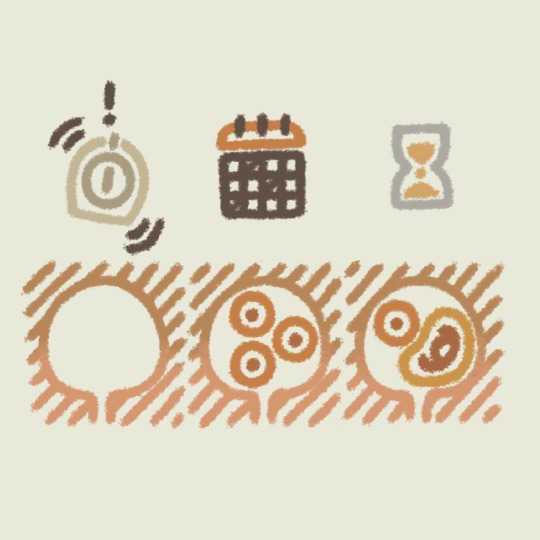
Otherwise, Faeries produce 3 or so eggs each month, and Fae stop new egg production once an egg is fertilized.
These eggs may be intentionally laid at any time, only needing to be laid once fertilized.

Lots of Faerie species also internally gestate their young.
Many Fae collect eggs to gain more magic and many lay their unfertilized eggs often, as keeping them can be very cumbersome.
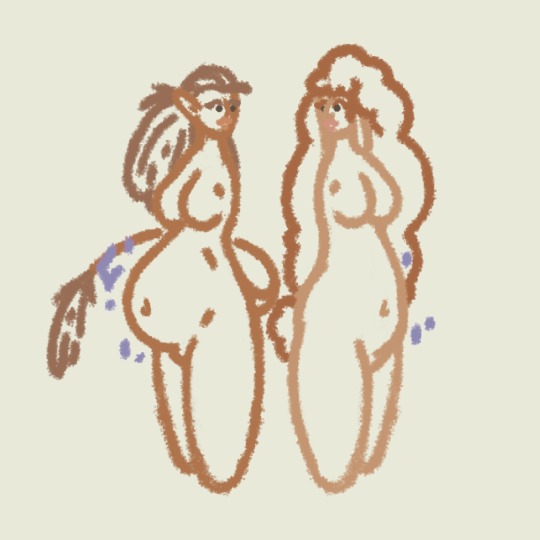
Due to this, most Faeries appear pregnant or chubby.
This means, to Faeries, having no visible belly, or just an overly flat stomach, can be seen as a sign of dishonesty. It can be seen as hiding something of one's core being.
Faeries are magical beings and attempting to hide part of that nature is often frowned upon.
#Faerie#Fairy#Lore#Art#Artist on Tumblr#Illustration#Description#Speculative Biology#Oc Art#Biology#Fictional Biology#Lore Dump#Original Content#Part 2
5 notes
·
View notes
Text
The Emperor toad, Bufo caesaris, is a small to medium sized amphibian native to southern europe.
Body is wedge-shaped and somewhat plump, with a fairly promounced skull. Colours vary from pale brown to grey, depending on population. Remarkabely, some individuals are known to discolour in early spring and turn a blood-red by mid-march.
The pigmentation of male Emperor toads differs from that of the females: Once they enter the later third of their life cycle, most males start developing a pattern of 21-60 short, thin stripes on back and torso. They can be red or black in colour. Individuals with more stripes appear to have an increased likelyhood of changing colour in spring (Brutus et al, -44) but further research is needed to support this claim.
Tadpoles are of average size and not easily distinguished from other species.
Driven to near-extinction by habitat destruction and an assasination attempt, these peculiar creatures are poorly understood. To battle this, a remarkable effort is made each March to remind the general public of the ecological importance and former cultural significance of this amphibian.
2 notes
·
View notes
Text
Higher Being Biology and Specifics: The Vessels
Alrighty, here's my third insane, crackhead rambling about fictional bug God biology, this one is quite a bit shorter than the others.
EDIT: I forgot to add a couple of bullet points, so I am adding them in. The last four of them are new additions.
The Vessels can all be classified as Pale Beings, just like their parents. However, because they have been hollowed out by Void, there are some key differences.
Like Pale Beings, the body temperature of the Vessels is incredibly cold. Furthermore, because they are Void constructs, their temperatures are even lower. Both their white shells and black, Void-infused chitin are freezing to the touch.
They do not give off a Pale Light like either of their parents.
None of them are able to speak. The only noise that they can make at all is a low rustling sound, akin to that of wind.
Upon the cracking of their shells, their Shades are released. Their Shades retain characteristics of the Vessels’ personalities, thoughts, and feelings. However, the Shades generally only retain imprints of negative emotions and pain, similar to that of a sullied stain. As such, they are aggressive in temperament.
Because their bodies are formed from Void, their forms can be contorted and changed at will. The Vessels can summon or conjure up tentacle-like tendrils and extra limbs from their bodies. They generally use the tendrils in battle.
The Vessels, like their mother, do not have mouths. Instead, they eat by grabbing food with their Void tendrils and absorbing it into their bodies. They can eat through any part of their body as long as their shells are not obstructing access to the Void.
The Vessels can easily repair damage to their bodies via the use of Void or Soul. When the injury to their Void-infused chitin is small, they can easily repair it. If it is a larger wound or even a loss of a limb, they must use Void to repair the injury or regenerate the lost limb. If their white shells are damaged, they are only able to heal such an injury by Focusing Soul.
They do not have traditional hemolymph or organs. Instead, they all bleed, cry, and vomit Void.
Unlike other Higher Beings, the Vessels do not have sexual organs, nor can they reproduce. Consequently, they are all genderless. However, because the Void of their bodies are all able to be manipulated and changed, they can warp their form to accommodate the act of mating.
If their shells are not cracked open immediately upon death, the Shade is stuck inside the inanimate Vessel. They are unable to move or do anything and are trapped in a sort of limbo. Breaking the shell will set the Shade free.
The Vessels are able to die of starvation and do have to eat to survive, however, they can live off very little food. A little energy goes a long way.
Being Void constructs, Vessels have incredible endurance and are able to withstand even the most intense physical exertion.
They moult and shed their shells to make way for new growth. The size they grow to depends on their diets and exercise.
#hollow knight au#hollow knight#au#aggressive headcanons#fictional biology#infodump#i am probably insane to be honest#crackhead hours#i type a shit ton#the vessels#shades#ramblings#yes#you should be worried for my mental health#void#i explain things badly
54 notes
·
View notes
Text
On The Biology of Endermen
A treatise on the diet of Endermen and how it affects them physiologically.
When one considers the diet of the ender species the chorus fruit is the most often thought of. A hard shelled sweet fruit. It is unable to be broken into without first cooking it causing it to "pop".
Endermen on the other hand, are able to eat them raw. Suggesting a jaw strength comparable to a bear. The teeth are most likely a majority of both bicuspids and molars. With only the first 4 teeth being incisors and no cuspids as there is little, to no, tearing in their diet.
Unlike popular belief, endermen are a herbivorous and sometimes insectivorous species. When chorus plants are in low supply they often turn to endermites for substance. This is unhealthy for the enderman as endermites burrow into the GI tract and can cause disorders that lead to erratic behavior and even death. It is a good idea if in an area with a large population of enderman to replant any chorus trees you may harvest so as not to wipe out any local populations.
Speaking of chorus trees, the enderman's long limbs evolved exactly to reach as far as possible among the trees for the fruits. This is unlike the Lamarck Theory of evolution, there was no stretching of limbs to reach the current length. Instead it was by Darwin's natural selection theory that the longer limbed endermen were chosen by potential mates.
In short; the cohabitation of the Chorus plant and the Enderman is a circuit, with endermen getting nutrients from the fruit and the plants being spread by seedings because of the endermen. And because of how the chorus fruit evolved the endermen changed to match their food source.
15 notes
·
View notes
Text
Our Chatot, Pesquet, is very curious about his berries! In the wild, Chatots feed on a wide variety of fruits, so we make sure to vary their diet and keep it interesting for them with all sorts of different berries.
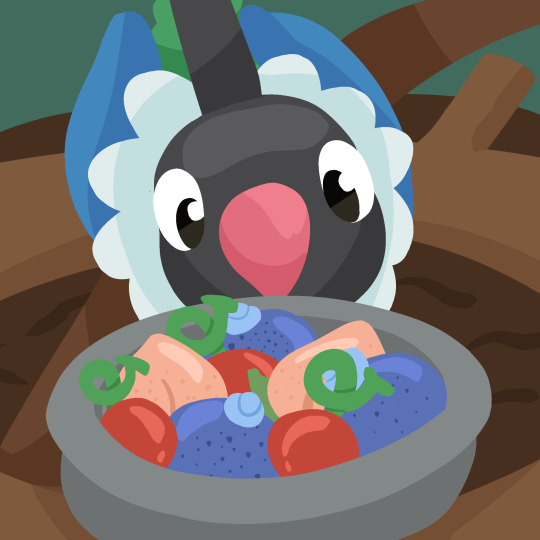
133 notes
·
View notes